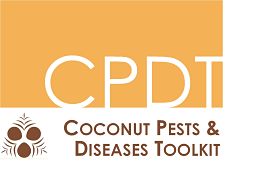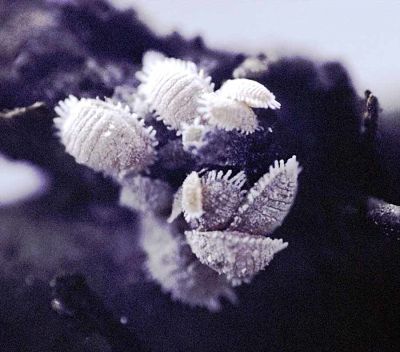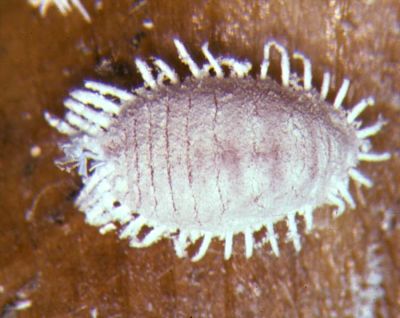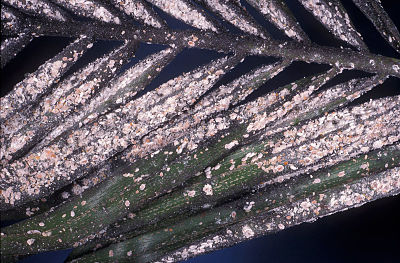Mealybug - pineapple
Pineapple mealybug is a pest insect of coconut and other economically important crops. There is a high risk of population outbreaks, but the economic risk to coconut plantations is low.
Common namePineapple mealybug |
Scientific nameDysmicoccus brevipes |
on this page: Life-cycle and identification : Symptoms : Impacts : Distribution : Prevention : Controlling pineapple mealybug : Information sources and further reading
Life-cycle and identification
Pineapple mealybugs are sap-feeding insects.
There are two types of pineapple mealybugs. One type has no males, only females (i.e., parthenogenetic), and this is commonly found around the world. The other type has both sexes.
The parthenogenetic female form reproduces without fertilisation and gives live birth to around 250 nymphs. This is called clonal reproduction or parthenogenesis. The significance of this means of reproduction is that only one female mealybug is needed to start a new colony.
Adult pineapple mealybugs can be seen on the roots, underside of leaves, stem nodes, fruit and the growing point. An ant species, Pheidole megacephala or African big-headed ant, is commonly seen protecting the mealybug colonies from predators, parasites and harsh climatic conditions. The ants build mud encasements around the mealybugs to protect them. In return the ants feed on the honeydew the mealybugs secrete.
Nymphs (crawlers)The first instar is the most mobile stage of a mealybug's life. These young nymphs are called crawlers. Crawlers will move to find feeding sites then move very little from here for the rest of their lives. Older nymphs resemble the adults with a waxy coating but are a light yellow colour with two longer wax filaments and the end of their body. Nymphs undergo 3 growth stages (instars) over 3-4 weeks, to reach their adult form. AdultsAdult pineapple mealybugs are 2.5 mm long by 1 mm wide (oval or half-sphere) and soft. The adults are pinky orange in colour and have distinct segments covered in a thick and woolly waxy substance. Adults (and nymphs) have short waxy filaments (like long hairs) around the edge of their body. Two longer pairs of filaments occur at the end of the body. The lifespan of an adult pineapple mealybug ranges between 31 - 80 days. Females will give birth to around 250 or more young over a course of time, usually every 25 days. The female will live up to around 5 more days after giving birth. SymptomsAs the pineapple mealybug feeds on the roots and the part of the stem underground, feeding damage may not be visible. However, the roots may look stunted and rotted. |
Small and light coloured nymphs among adult pineapple mealybugs (© John Thomas, University of Queensland)
Pink-orange adult pineapple mealybug with short waxy filaments (© Lyle Buss, University of Florida) |
|
A specific symptom of mealybug infestation is black sooty mould which can be seen on the fronds and fruit. This is from the honeydew that mealybugs excrete while feeding. With the sooty mould covering much of the leaf area, photosynthesis ability is greatly reduced. The growth of coconut may seem slower and may appear wilted and weak. Additionally, the undersides of the leaves may also show yellow spotting with early shedding. Pineapple wilt viruses are associated with Dysmicoccus brevipes and closely related species. Impacts |
Sooty mould growth from mealybug colony honeydew secretions (© Lyle J. Buss, University of Florida) |
Coconuts damaged by the pineapple mealy bug are likely to have an effect on the income from coconut productions. Slow growth, smaller fruit and the appearance of sooty moulds can drastically reduce the trading of produce.
If Dysmicoccus brevipes is not controlled there is a high risk of spread to pineapple plantations. These plantations are vulnerable to Pineapple mealybug-associated wilt virus, which has been reported in the Cook Islands and Fiji.
Severe damage is likely to occur on introduction to new areas (especially without natural predators and unregulated chemical treatments which kill them).
Distribution
Pineapple mealybug are found throughout most of the world.
In the Pacific it has been reported in American Samoa, Australia, Cook Islands, Fiji, French Polynesia, Guam, Kiribati, Marshall Islands, New Caledonia, Niue, Northern Mariana Islands, Palau, Papua New Guinea, Samoa, Solomon Islands, Tokelau, Tonga, Tuvalu, Hawaii, Vanuatu, and Wallis & Futuna.
Please check with your local biosecurity / quarantine or SPC for up-to-date distribution information.
Prevention
Most importantly, the International Guidelines for transfer of coconut germplasm should be strictly followed to prevent pests and diseases being moved to new locations.
Pineapple growers importing pineapple for planting should be aware of the areas where mealybug wilt of pineapple occurs. It is not recommended to import pineapple from these areas.
As the pineapple mealybug attacks many important crops, there is a high risk of introduction nationally and internationally through transport methods (water, air, on other animals).
For general information on preventing pests and diseases of coconut, see the Prevention section.
Controlling pineapple mealybug
We strongly recommend an integrated pest management (IPM) approach to the control of all insects, where possible. This is a combination of methods (spot application of pesticides, physical controls such as site hygiene, and biological controls) to minimise the use of pesticides and their negative impact on natural enemy populations, so minimising pesticide costs.
Integrated Pest Management (IPM)
The goal of IPM is to keep pest populations to a level below which they cause economic harm. IPM involves using multiple control options together for the economic control of pests (i.e. cultural, natural and chemical).
In an agricultural context the Food and Agriculture Organization defines IPM as "the careful consideration of all available pest control techniques and subsequent integration of appropriate measures that discourage the development of pest populations and keep pesticides and other interventions to levels that are economically justified and reduce or minimize risks to human health and the environment. IPM emphasizes the growth of a healthy crop with the least possible disruption to agro-ecosystems and encourages natural pest control mechanisms".
A combination of methods currently used and recommended before planting, throughout the growth, and the harvest to stop the spread and outbreaks of pineapple mealybugs.
If ant colonies are not controlled, mealybug control is not likely to be successful. The ants also remove the honeydew excreted by the mealybugs, thus preventing its accumulation and the potential growth of sooty mould, both of which can be harmful to the mealybugs. The ants also carry the mealybugs to new host plants, as they extend their territory.
To ensure the following methods are successful, it is recommended to control ant populations that may be protecting mealybug populations. More information and advice on getting rid of ants can be found on the Pacific Invasive Ant Toolkit.
Cultural
Heat treatments have been used successfully to control pineapple wilt-associated viruses. Treatments of hot (50°C) water on the crowns for 30 mins have been shown to reduce mealybug colonisation. This treatment is applied to coconuts before planting near pineapple crops.
Coconut palms that are severely infested should be removed and destroyed by burning.
The soil should be well prepared before planting or replanting. This includes ploughing and treating it to kill ant colonies that help the mealybugs survive.
Leaving the soil for a period of time (once debris is decomposed or ploughed in) before planting is recommended to ensure it returns to a fertile state. Ploughing around the palm may also be useful to remove ant and mealybug colonies and increase the fertility of the soil for the next harvest.
After planting, keep the surrounding areas cleared from weeds and debris as these provide shelter for mealybugs and ants.
After the harvest is complete, loose plant material should be removed and burnt. Ploughing of this debris can also aid soil fertility.
Natural
Many natural predators of pineapple mealybugs have been used for their control. Ladybird beetles (coccinellids), parasitoid wasps (encyrtids) and midges (cecidomyids) are commonly used.
These natural controls can be very effective with the additionally control of the ants that provide protection for mealybugs.
Baited traps for ants may be useful in allowing mealybugs to be naturally controlled by their predators and biological control agents.
Chemical
Insecticides have been used for treating the crowns of palms prior to planting to reduce the spread of mealybugs.
Dipping in a mixture of diazinon with white oil or horticultural oil is one approach. However, it is recommended to try the oil first to see if it will reduce mealybugs alone as diazinon is highly hazardous and classed as a group 1B insecticide. Synthetic pyrethroids may also be used when needed.
As these insecticides kill all insects they will be effective on ants as well as mealybugs. However, there are better methods for dealing with ants. More information and advice on getting rid of ants can be found on the Pacific Invasive Ant Toolkit.
Information sources and further reading
Egelie, Gillett-Kaufman. 2015. Featured creatures; pineapple mealybug. [ONLINE]
Infonet Biovision. 2018. Mealybugs. [ONLINE]
Invasive Species Compendium. 2018. Dysmicoccus brevipes (pineapple mealybug). [ONLINE]
PIAT. 2018. The Pacific Invasive Ant Toolkit. [ONLINE]
PestNet. 2017. Pineapple mealybug. [ONLINE]
Plant Village information on Coconut; Diseases and Pests, Description, Uses, Propagation.[ONLINE]
content reviewed by Gillian Watson, August 2018



